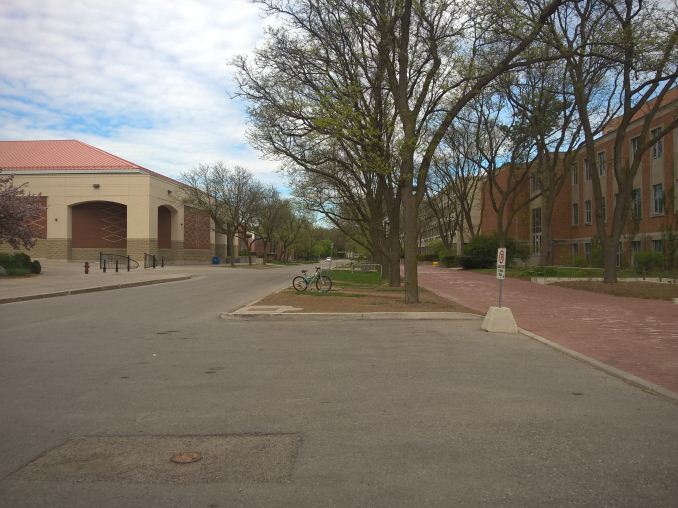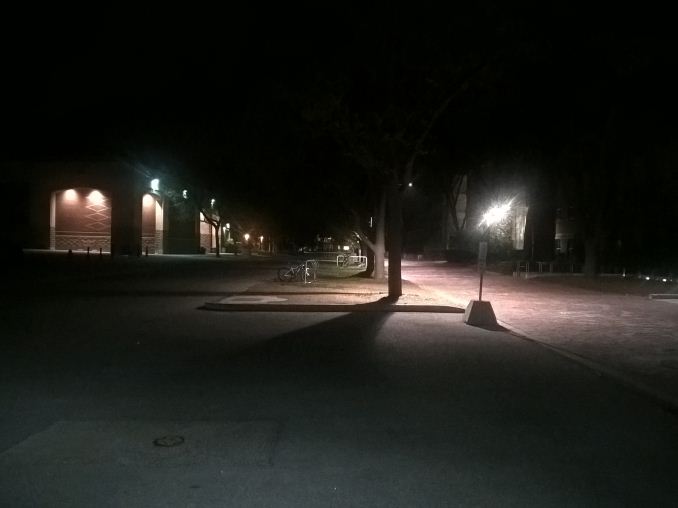The Microsoft Lumia 640 Review
by Brandon Chester on June 9, 2015 8:00 AM EST- Posted in
- Smartphones
- Microsoft
- Mobile
- Lumia
- windows phone 8
Still Image Performance
Now that we’ve gotten the basics of the Lumia 640’s camera system and camera software out of the way, we can move on to evaluating the actual image quality. The most relevant phone to compare to will be Motorola’s Moto E, which sells for around the same price but sports only a 5MP rear-facing camera.
The first photo comparison is the standard daylight test scene that I use. The branches of the trees in the frame are a good test of spatial resolution, while the various different textures can be examined to see how the phone handles noise reduction and maintains detail during processing.
With ample lighting, the Lumia 640 performs very well considering its price. I do find that the Lumia 640’s white balance tends just a tiny bit too far toward yellow in this case, and colors are a bit undersaturated, but the overall image quality is pretty good. When you compare it to the Moto E, it’s clear that the Lumia 640 is much sharper across the entire frame, and ends up maintaining much more detail. A good example is the brick texture of the red building on the left, which is maintained in the Lumia 640’s shot but completely scrubbed away in the Moto E’s photo.
As for comparisons to other 8MP smartphones, the Lumia 640 tends to fall behind when it comes to sharpness. The Nexus 5 with its larger sensor ends up capturing the tiny interlocking branches of the trees with much more sharpness, and maintains the black bars of the furthest gate on the left which have become a grey unresolved area in the Lumia 640’s photo. This doesn’t mean that the Lumia 640 performs poorly relative to its price. On the contrary, its performance in daylight is extremely good for a $129 device.
While even the most inexpensive devices can now produce usable photos when there's good lighting available, low light photos tend to be where devices stumble. To see how the Lumia 640 performs in low light, I've taken photos of the same scene as above but at night. With the sun having set, the only sources of light in the frame are a handful of lamps on buildings and along the red brick road.
In the low light scene, the Lumia 640 actually performs better than I had expected. I would say it actually outperforms the Nexus 5. While it doesn't show as much in the scene as the Nexus 5 due to its exposure, and not near as much as the iPhone 5s, it has very fine noise and good sharpness in the areas that are exposed. The Nexus 5 by comparison shows a small bit of the sky and the leaves of the first tree, but the entire image suffers from distracting chroma noise which ruins much of the detail. I certainly didn't expect this from a 1/4" sensor without OIS, and much of it is thanks to Microsoft's superb image processing. My one complaint is that there's a lot of flare from all of the light sources in the scene, and the lamp on the right is particularly distracting because of it.
As far as smartphones in the $100-150 range go, the Lumia 640 definitely has the best camera I've seen to date. The Moto E simply can't compete with its smaller 5MP sensor, and Microsoft's high quality image processing ends up producing photos that are better than the 13MP ZenFone 2 in many ways, which goes to show how a device's image processing is just as important to image quality as the actual sensor itself.
Video Performance
The other side of a phone's camera quality is how it performs when taking video. Taking videos is also arguably a more intensive test of a device's camera system than taking still photos, as device's image signal processor has only a short time to process images. There's also no way for devices with OIS to use it to enable long exposure times, as the exposure time for each frame can't be any more than 42ms, and usually less.
The Lumia 640 can capture 1080p video at 24, 25, and 30fps. For this test I opted for the 30fps mode, as the higher frame rate comes with less motion blur. The Lumia 640 encodes its 1080p30 video with an average bitrate of 17.6Mbps using the H.264 Main profile.
Video footage from the Lumia 640 ended up being quite decent. The bitrate is just as high as high end smartphones, and the footage isn't really any blurrier or noisier than what you'd get from something like the iPhone 6 at the same resolution and frame rate. My one complaint is that Microsoft's EIS doesn't seem quite as effective as the EIS that I've seen on other smartphones, and as a result the footage is a bit shakier. There are also some fairly dramatic changes in exposure and white balance when changing the target of the shot, and in certain circumstances such as when the camera is being pointed at red flowers it actually ends up making the video look too cold. However, the overall video quality is very good, and is miles ahead of other inexpensive devices that I've looked at recently like the ZenFone 2 and the Moto E.
























130 Comments
View All Comments
WinterCharm - Tuesday, June 9, 2015 - link
That's a really nice phone for the price! :DGreat look and design, too!
JohanAnandtech - Tuesday, June 9, 2015 - link
That kind of performance is going to get frustrating pretty quickly. Simply using some kind of navigation will quickly show the limits of using an A7 core.Wolfpup - Tuesday, June 9, 2015 - link
On Android an A9 is dirt slow, while it's not bad running real Windows, much less Windows Phone.I've got a 520 and a 635, and the A7 isn't an issue in the 635 at all...at least not for the stuff most people do (certainly including navigation software). This 640 looks like an awesome extension...2x the RAM and a larger screen. Naturally it's coming out not long after I bought a spare 635 lol
jospoortvliet - Thursday, June 11, 2015 - link
As the review makes clear - Windows Phone lost its advantages in terms of performance...jakoh - Thursday, June 11, 2015 - link
The review compares the 640 to a bunch of high spec'd android and IOS, it doesnt show that WP can run smoothly even on crappy specs.leexgx - Thursday, June 11, 2015 - link
i do agree i got a nokia 820 seems to work wellBut the Main problem with windows phones is lack of ram some times background tabs are deep suspended and take to long to restore i ignore any windows phone with 512mb of ram but would recommend 2GB as a minimum
darkich - Friday, June 12, 2015 - link
You clearly didn't even read the article.The author was specifically comparing this to low end Motorola moto E performance wise.
And he stated for several times that the whole OS and browser feel really slow in comparison.
SirPerro - Monday, June 15, 2015 - link
"I mentioned in my Moto E review that for a long time I recommended that users who wanted a cheaper smartphone go with Windows Phone over Android, because at the time the options on Android were janky, slow, and offered a poor experience. I can’t make that recommendation anymore, because the app gap is still here, while the experience gap in favor of Windows Phone is gone."Article is loud and clear
Murloc - Tuesday, June 9, 2015 - link
not really, I have a 635 and the experience is fluid.testbug00 - Tuesday, June 9, 2015 - link
Really? L520 running quite smoothly through everything I throw at it (web browsing, some music playing, few notes in OneNote) andf it's a dual core A7 chipset (SD200)./yawn